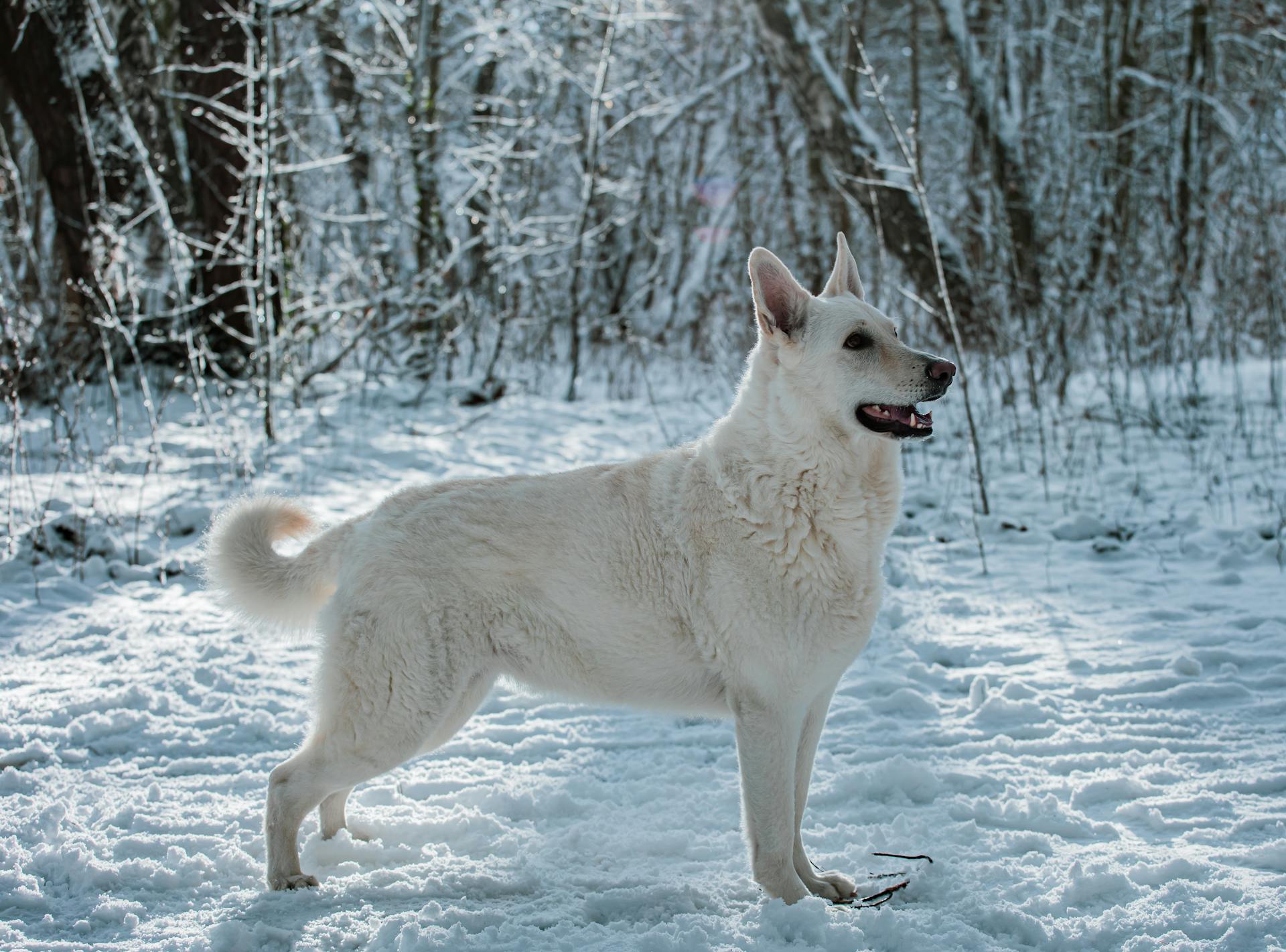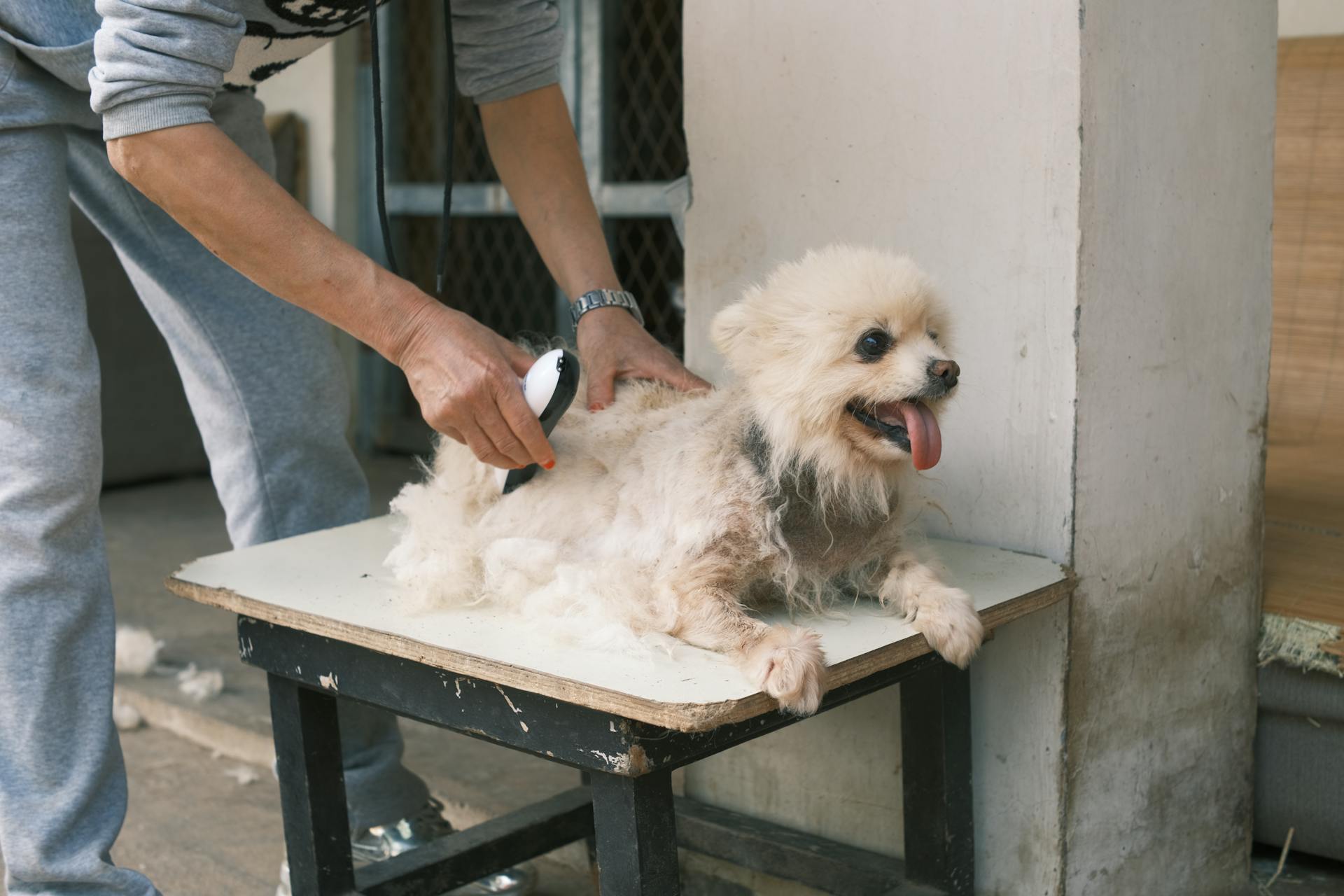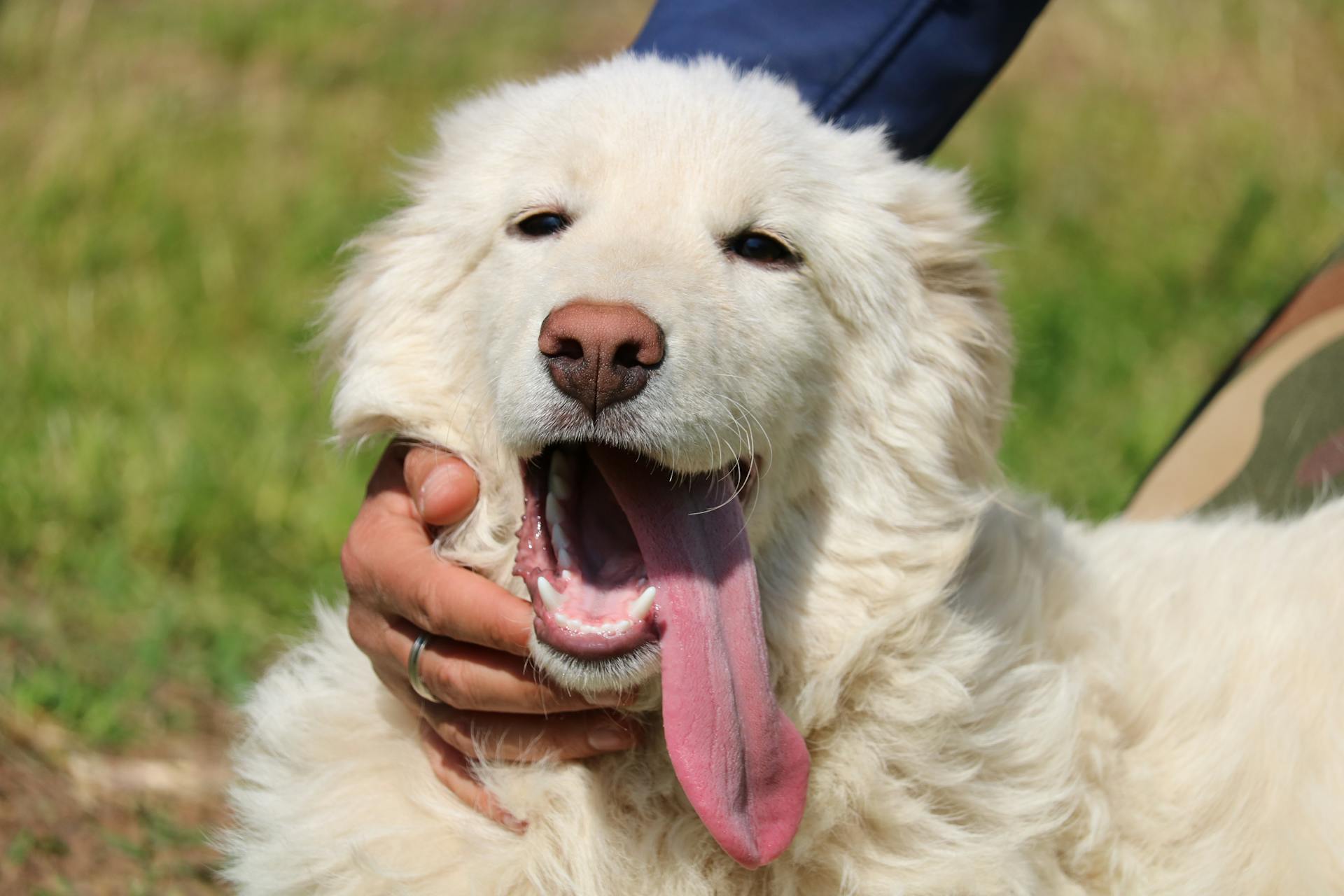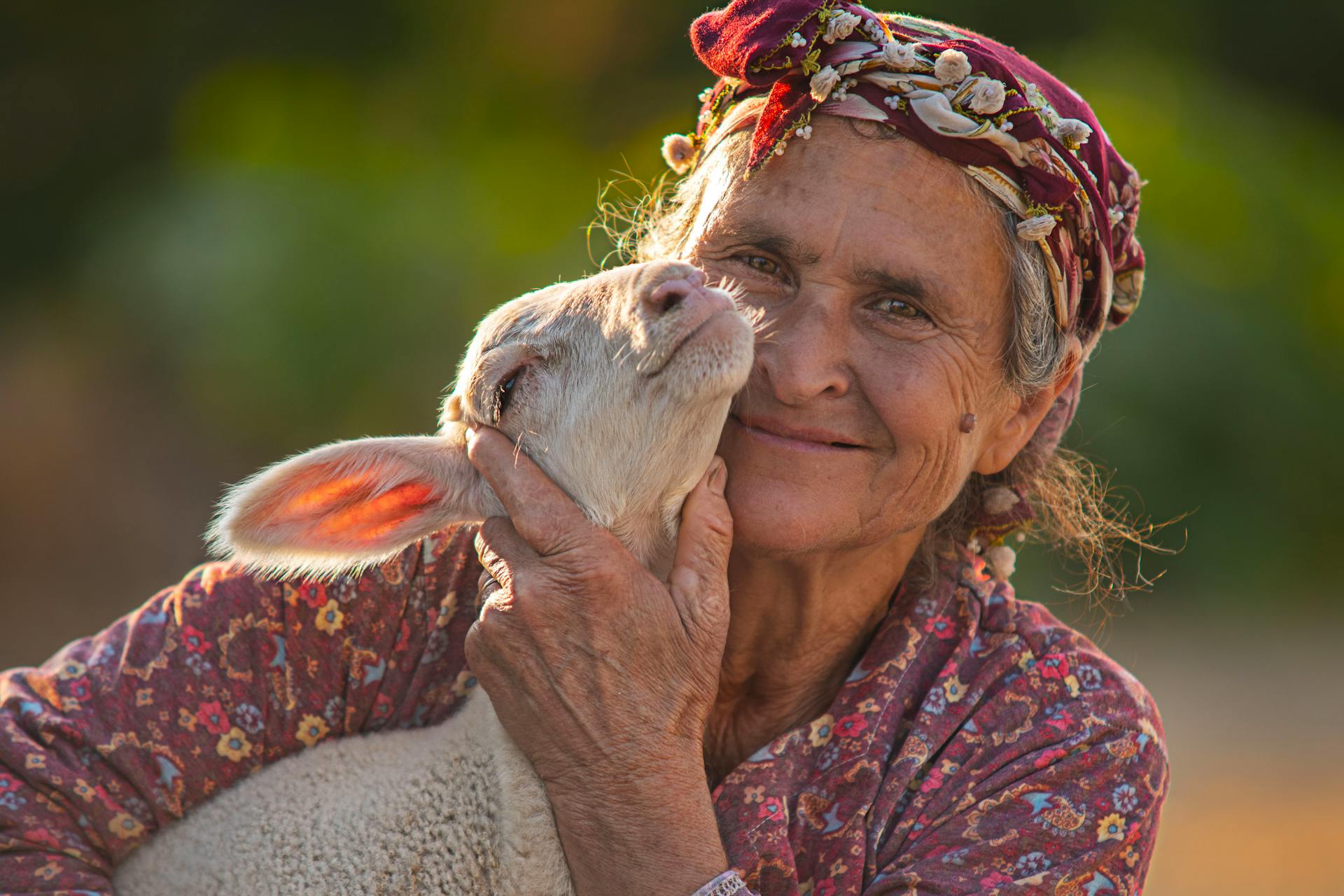
The Komondor is a unique and fascinating dog breed that originated in Hungary. They were originally bred to guard livestock.
Their distinctive corded coat is one of the breed's most recognizable features. It's made up of thick, matted fur that resembles a mop.
Komondors are naturally protective of their family and territory, making them excellent watchdogs. They're not typically aggressive, but they will defend what's theirs if necessary.
In terms of size, Komondors are a medium to large breed, with males weighing up to 120 pounds.
Physical Characteristics
The Komondor's coat is a long, thick, and strikingly corded white coat, about 20 – 27 cm long, which resembles dreadlocks or a mop.
The coat is wavy and tends to curl as the puppy matures, and it takes about two and a half days to dry after a bath.
A fully mature coat is formed naturally from the soft undercoat and the coarser outer coat combining to form tassels or cords, and it takes about two years to form.
The Komondor is born with only a white coat, unlike the similar-looking Puli, which can be white, black, or sometimes grayish.
The Komondor's head is broad but should appear in proportion with the size of the body, and it has a short, broad, rather coarse muzzle.
The Komondor has a large head, but the muzzle is quite short and dark, and the eyes are almond-shaped, dark brown, and medium in size.
The Komondor's ears are an elongated triangle shape with a rounded tip, and they blend beautifully with the rest of the coat.
The Komondor's tail is long, reaching down to the hocks, and it is never carried above the level of the back.
The Komondor's body is slightly rectangular, with a broad and deep muscular chest, and the back is short, broad, and muscular.
The Komondor's hindquarters are strong and muscular, with legs fairly wide apart, parallel, and well angulated.
The Komondor's coat is long, dense, and double, with a coarse outer coat and finer undercoat, and it must naturally tend to cord or matt.
See what others are reading: Muscular Boston Terrier
The coat is longest on the croup, the loin, and the upper thighs, and it is a little shorter on the back, sides of the chest, and shoulders.
The Komondor's coat is slow in cording and may not be fully formed before two years of age, and if neglected, it forms into large, matted 'plates'.
Temperament and Training
The Komondor's temperament is a unique blend of calmness and protectiveness. They're naturally wary of strangers, but can warm up to them when it's clear they mean no harm.
The Komondor is a faithful and devoted breed, but they require respect and proper training. They can become obstinate if bored, so training sessions should be upbeat and happy.
Consistency is key when training a Komondor. They need to be socialized early on to new situations, people, and other dogs, and praise and consistent corrections are essential to ensure a well-adjusted adult.
Here are some key points to keep in mind when training a Komondor:
Temperament
The Komondor's temperament is a unique blend of calmness and fierce protection. It's built for livestock guarding, so it's no surprise that it's naturally wary of strangers.
This dog is affectionate with its family, gentle with children and friends, but can be wary of new people until it's clear they mean no harm. They're very protective of their family, home, and possessions.
The Komondor is a great companion for families with other pets, as it's often very protective of them. However, it's not tolerant of trespassing animals, making it unsuitable for apartment living.
As a livestock guardian, the Komondor is vigilant and will rest during the day, keeping an eye on its surroundings. But at night, it's constantly on the move, patrolling its territory.
Here are some key characteristics of the Komondor's temperament:
- Calm and steady when things are normal
- Fearless when defending its charges
- Affectionate with its family
- Wary of strangers
- Protective of its family, home, and possessions
- Vigilant and alert to its surroundings
Training
Training a Komondor requires early start, ideally between 4-8 months, to prevent potential dangers due to its size, power, speed, and temperament.
A Komondor can become obstinate if bored, so training sessions should be upbeat and happy.
Praise is essential in training a Komondor, and consistent and humane corrections are necessary to prevent hostile behavior.
Consistent corrections, even with a young puppy, are crucial to ensure a well-adjusted adult Komondor.
Socialization is extremely important for a Komondor, as it's a natural guard dog that may react aggressively in new situations without proper exposure.
In fact, socialization should start early, exposing the puppy to new situations, people, and other dogs.
Breed-specific legislation requires some breeds to be muzzled in public places, and Romania is the only country that requires Komondors to be muzzled.
Expand your knowledge: Lancashire Heeler News
Maintenance and Care
The Komondor's unique haircoat is a high-maintenance aspect of their grooming. It should never be brushed or combed, but rather divided into cords and trimmed regularly.
Bathing is a must, but it's essential to do so sparingly to prevent ruining the thickness of their white coat. This can take a long time to dry, so using a fan or blow dryer can speed up the process.
Regular exercise is crucial to keep your Komondor fit and healthy, so daily brisk walks are a must.
Uses
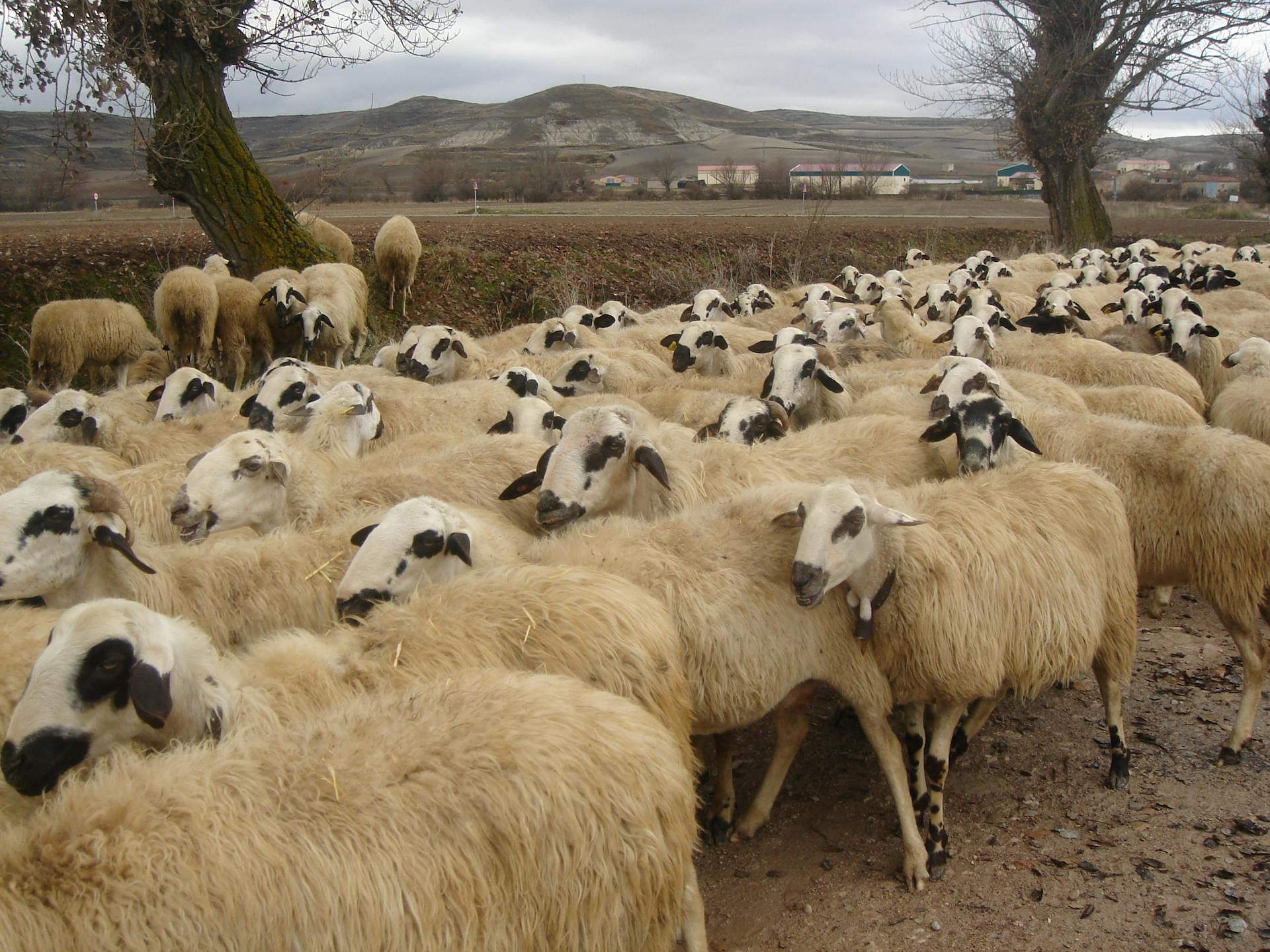
The Komondor's natural guardian instinct makes it an excellent choice for guarding livestock, and its athletic ability allows it to leap at predators to drive them off or knock them down.
Its thick coat provides protection against wild animals, weather, and vegetation, making it a reliable guardian. The coat's unique appearance also allows it to blend in with a flock of sheep, giving it an advantage when predators attack.
With its strong build and powerful physique, the Komondor is more than a match for predators like coyotes, cougars, bears, and other threats to sheep and goats.
Suggestion: Border Collies Herding Sheep
Breed Maintenance
The Komondor breed requires regular exercise to stay fit and healthy, so daily brisk walks are a must.
Their thick coat needs to be divided into cords and trimmed regularly to keep it clean and free of debris.
Bathing is necessary, but it's essential to do it sparingly to maintain the thickness of their white coat.
It takes a long time for their coat to dry, but using a fan or a blow dryer can speed up the process.
They're not suited for small yards or town environments, as they need room to roam and high fences to keep them safe.
If they're not working, they can become lazy and sleep for hours on end, so daily exercise is crucial.
Their coat upkeep, bathing, and regular checks for ear and eye infections are all essential maintenance tasks.
Similar Maintenance Breeds
If you're considering a Komondor as a pet, you might want to know about similar breeds that require similar maintenance. The West Highland White Terrier, also known as the Westie, is 96% similar in maintenance needs.
These breeds all have thick coats that need regular grooming to prevent matting and tangling.
The Berger des Pyrenees, a large and majestic breed, is also 96% similar in maintenance needs to the Komondor.
If you're willing to commit to regular grooming, the Thai Ridgeback's 90% similarity in maintenance needs might make it a good choice for you.
The Shetland Sheepdog, or Sheltie, is another breed that's 90% similar in maintenance needs to the Komondor.
Expand your knowledge: Dogs Similar to Border Collies
Frequently Asked Questions
Do komondors hair naturally dread?
Komondors' cords, not traditional dreadlocks, form naturally by 2 years old, requiring regular maintenance to keep them clean and neat. This unique feature sets them apart from other breeds.
Do Komondor dogs bark a lot?
Yes, Komondor dogs are known for their loud and persistent barking, which they use to alert and protect their family and home. Their barking is a key characteristic of the breed and a testament to their loyal and watchful nature.
Is a Komondor a good pet?
A Komondor can make a loyal and loving pet for the right owner, but they require significant time and attention to care for their unique coat and may have a strong protective instinct. If you're willing to invest in their needs, a Komondor can be a rewarding companion
Are Komondor dogs rare?
Yes, Komondor dogs are considered rare due to a worldwide population of less than 10,000. Despite their rarity, they can be found in significant numbers in Hungary and the United States.
What is the most famous Hungarian dog?
The Komondor is considered the most striking and iconic Hungarian dog breed, known for its unique corded fur and noble disposition. It's often referred to as "the king of dogs, the dog of kings
Featured Images: pexels.com
